ETH ZuricH - ETH - Finanzen und Controlling - ETH Zürich
ETH ZuricH - ETH - Finanzen und Controlling - ETH Zürich
ETH ZuricH - ETH - Finanzen und Controlling - ETH Zürich
Create successful ePaper yourself
Turn your PDF publications into a flip-book with our unique Google optimized e-Paper software.
38 Social commitment – Services<br />
39<br />
Eyjafjallajökull: ash measurements confirm the official decision<br />
Gotthard breakthrough: a success for <strong>ETH</strong> Zurich too<br />
In April, the ash-laden eruption of the Icelandic volcano<br />
Eyjafjallajökull brought air traffic in the northern hemisphere<br />
to a standstill for days. While everyone in Europe was<br />
loudly debating whether or not the flight ban was justified<br />
on the basis of modelling of the ash clouds, <strong>ETH</strong> scientists<br />
from the Institute for Atmospheric and Climate Science<br />
were the first to use sophisticated measuring equipment<br />
to determine the concentration of ash particles in the ash<br />
clouds over continental Europe. The measurements taken<br />
by the team led by <strong>ETH</strong> Professor Thomas Peter showed that<br />
the closing down of the air space to aircraft was not an excessively<br />
cautious move. In the night from 16 to 17 April 2010,<br />
one of the probes, at four kilometres up in the air, measured<br />
about 80 micrograms of volcanic particles per cubic metre<br />
of air, with an estimated average diameter of about 3 micrometres.<br />
A few days later, the researchers even detected a<br />
concentration of up to 600 micrograms per cubic metre of<br />
air. To compare: on average over the year, the concentration<br />
of fine dust in Zurich is about 50 micrograms per cubic metre.<br />
The researchers came to the conclusion that, to make a<br />
scientifically so<strong>und</strong> decision, tests would have to be carried<br />
out on aircraft engines to find out what volume of volcanic<br />
particles they could withstand. Without working out a limit<br />
value in this way, the air space could not be opened up with<br />
such a concentration of particles, because the risk was too<br />
great. If the aerosols (minute particles) of glass-like ash got<br />
into the jet engines of the aircraft, they could be melted by<br />
the tremendous heat there and stick to the turbines, which<br />
would cause malfunctions.<br />
<strong>ETH</strong> expertise<br />
To carry out the measurements, the scientists released measuring<br />
balloons into the sky which penetrated the clouds of<br />
In November, the Postgraduate Study Programme on Developing<br />
Countries (NADEL) celebrated its 40th anniversary. On<br />
the continuing education courses run by NADEL, including<br />
the Master of Advanced Studies, university graduates are<br />
trained to work with developing countries. Some courses<br />
are specifically aimed at specialists already working in the<br />
field of partnership with developing countries. The postgraduate<br />
programme is part of the Department of Humanities,<br />
Social and Political Sciences (D-GESS) at <strong>ETH</strong> Zurich, and,<br />
in addition to providing education, it also conducts research,<br />
mainly on economic and social science aspects of working<br />
with developing countries. NADEL employees also carry out<br />
<strong>ETH</strong> scientists calculated the concentration of ash particles in the<br />
ash clouds from the volcano Eyjafjallajökull.<br />
aerosols. Secured to the balloons were backscatter cloud<br />
probes developed by <strong>ETH</strong> Zurich, the first of their kind in the<br />
world. The probes, the size of a cigarette packet, can emit<br />
light on two wavelengths. The light is deflected back by the<br />
ash/glass particles and measured by the probe. By analysing<br />
the backscattered light, the scientists are able to estimate<br />
the number density and size of the aerosol particles. The<br />
product of these two figures provides the concentration of<br />
ash/glass particles in the atmosphere.<br />
Y www.iac.ethz.ch/groups/peter<br />
40 years of training and research for developing countries<br />
scientific consultancy work for development organisations.<br />
Over the past 40 years, more than 600 new specialists have<br />
been trained on the postgraduate courses at NADEL (and<br />
its predecessor INDEL). 700 people have participated in individual<br />
continuing training courses and about 250 students<br />
have completed a Certificate of Advanced Studies. NADEL<br />
currently employs 18 staff, 10 lecturers and an ever-growing<br />
pool of over 60 guest lecturers from Switzerland and<br />
elsewhere.<br />
Y www.nadel.ethz.ch/index_EN<br />
The breakthrough of the east tunnel of the Gotthard Base<br />
Tunnel took place on 15 October 2010. This marked one of<br />
the most important milestones in this major construction<br />
project of the century. Since the late 1990s, research groups<br />
from <strong>ETH</strong> Zurich have been closely involved in the building<br />
of the two tunnels between Erstfeld and Bodio, alongside<br />
the developer AlpTransit Gotthard AG (ATG) and dozens of<br />
engineering companies. Georgios Anagnostou, Professor<br />
in Undergro<strong>und</strong> Construction at the Institute for Geotechnical<br />
Engineering, is a member of the AlpTransit Expert Advisers<br />
Group and assists project managers on matters relating<br />
to the tunnelling. The findings of his predecessor, Kalman<br />
Kovári, and of the Construction Technology working<br />
group, led to the development of a range of new measuring<br />
instruments, calculation procedures and testing techniques<br />
which made a vital contribution to the success of<br />
the project.<br />
Kovári and Anagnostou advised ATG, among other things,<br />
on the notorious Tavetsch Intermediate Massif, a 1.1 kilometre<br />
long geological fault zone beneath Sedrun. Ten to fifteen<br />
million years ago, the kakirites there were crushed <strong>und</strong>er<br />
enormous pressure, so that now the rock crumbles in your<br />
hand. At one time, critics of the tunnel regarded the Intermediate<br />
Massif as one of the main reasons why the project<br />
would fail. Anagnostou’s team helped ATG by carrying out<br />
laboratory tests as the construction work proceeded. By<br />
using modelling calculations, the researchers were able to<br />
judge how the rock would behave when the tunnel was driven<br />
through it. It was only thanks to these that it was possible<br />
to pass through the Tavetsch Intermediate Massif safely.<br />
Predicting torrents and correcting deflections<br />
Simon Löw, Professor of Engineering Geology at the Geological<br />
Institute at <strong>ETH</strong> Zurich, an expert in the flow of gro<strong>und</strong><br />
water during tunnelling, is still advising ATG now that the<br />
breakthrough has been made. During the months before<br />
the breakthrough, up to 20 litres of water a second were<br />
flowing from sometimes barely visible crevices in the east<br />
tunnel near Faido. Such quantities are not a problem for the<br />
miners. It was a different matter during the digging in Erstfeld:<br />
there up to 400 litres of water a second were flooding<br />
into the tunnel. In the early 1990s, Löw and his researchers<br />
had calculated the flows which could be expected, and<br />
were therefore able to estimate in advance how much water<br />
could be expected in certain sections of the mountain.<br />
For two tunnel boring machines to meet in the middle<br />
of a mountain requires very careful surveying. Hilmar Ingensand,<br />
Professor at the Institute of Geodesy and Photogrammetry<br />
at <strong>ETH</strong> Zurich, advised ATG on navigating the<br />
tunnel boring machines, partly with the use of an inertial<br />
For two tunnel boring machines to meet requires very accurate<br />
surveying – and the expertise of <strong>ETH</strong> Zurich.<br />
measuring system developed by Ingensand with colleagues<br />
from the TU Munich. By using fixed points on the surface,<br />
the researchers were able to transmit the direction of travel<br />
for the tunnel boring machine via the inertial measuring<br />
system down the 800 metre shaft in Sedrun into the tunnel<br />
and to monitor and confirm the gyroscope measurements<br />
used as the tunnelling advanced. Four tunnel boring<br />
machines were used for the two parallel tunnels. There<br />
were two in the north near Amsteg and Erstfeld and two in<br />
the south near Bodio and Faido. The 3000-tonne monsters<br />
were continuously directed and navigated along the ideal<br />
route by the surveying experts using laser beams.<br />
The tunnel, the longest in the world at 57 kilometres, is<br />
expected to go into operation at the end of 2017; it will significantly<br />
shorten journey times at the heart of Europe.<br />
Y www.tunnel.ethz.ch/index_EN<br />
Y www.engineeringgeology.ethz.ch<br />
Y www.geometh.ethz.ch


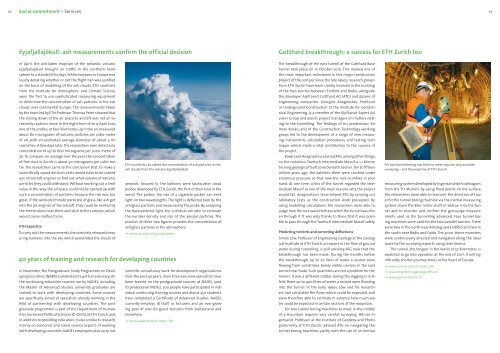
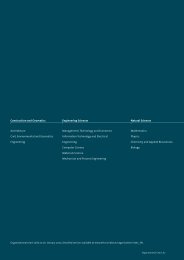
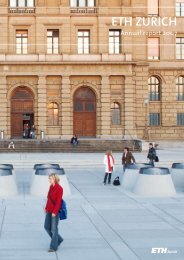


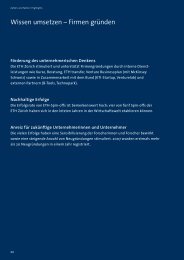
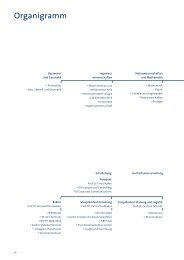
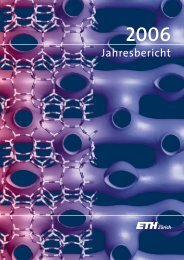
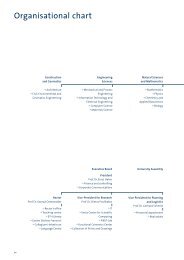

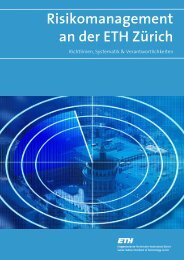

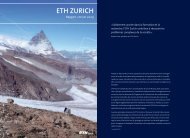
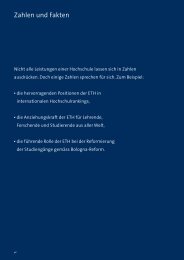
![DFC Newsletter Ausgabe 2006/09 September [Deutsch] (PDF, 103 kB)](https://img.yumpu.com/38538463/1/184x260/dfc-newsletter-ausgabe-2006-09-september-deutsch-pdf-103-kb.jpg?quality=85)